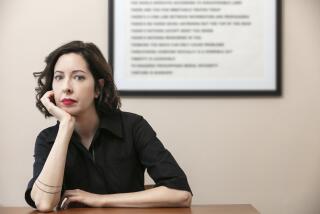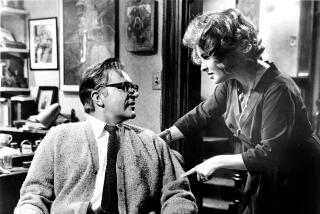Irreconcilable differences?
Many of the world’s greatest writers, including women-haters like Arthur Schopenhauer and August Strindberg, believed that marriage and art were incompatible. Art, they argued, was a sort of monastic vocation, for men only. Domestic life was its natural enemy, and the best women could do was offer silent support.
Some were perfectly happy with that choice. Others found it a terrible burden. The philosopher Friedrich Nietzsche, for instance, agonized over the sacrifices required of him. He exclaimed that all the things he needed as a philosopher -- freedom from wife, child, profession, fatherland and creed -- were deprivations to a living human being.
The novelist Thomas Mann, strongly influenced by Nietzsche, believed that great art evolved from isolation and suffering, and that the dedicated artist could never be happy in the ordinary way. But this did not prevent him from marrying and having six children.
W.B. Yeats wrote decisively in “The Choice”: “The intellect of man is forced to choose, / Perfection of the life or of the work.” But in real life, he too had both muse and wife -- the beautiful Maud Gonne, who rejected him, and his sturdy wife, George.
In his story “Lesson of the Master,” the sociable but inveterate bachelor Henry James expressed the inherent conflict between family life and the higher pursuit of art. His fictional literary lion, Henry St. George, explains to an aspiring author that the young man’s marriage would interfere with the sacrificial quest for artistic perfection, and that he should devote himself to intellectual rather than personal passion. When the young man asks, “Are there no women who really understand -- who can take part in a sacrifice?” St. George loftily responds, “How can they take part? They themselves are the sacrifice.”
The conflict between marriage and art was at its fiercest in Franz Kafka, a wretched and reluctant lover, twice engaged but never married. He could not endure life alone, but in characteristically extreme form, he summarized all the arguments against marriage: He needed solitude in order to create; he hated everything that distracted him from art; he thought marriage would enslave him to his tedious job; and he feared being swallowed up by a woman.
Worst of all, a happy marriage would undermine the very basis of his work -- the anguish, torment, pathological sensitivity, morbid introspection, self-hatred, self-torture and fanatical commitment to the “disease” of literature.
Yet not all writers have argued for solitude. Another tradition runs counter to the belief that the artist must pay dearly for his divine gift, and that the ruthless passion for creation clashes with the instinctive human longing for love, happiness and emotional security.
Serious modern writers from Tolstoy, Shaw and Conrad through Joyce, Virginia Woolf, Katherine Mansfield and D. H. Lawrence to Hemingway and Fitzgerald found in marriage a confirmation and extension of the self, a stronghold of affection that encouraged and tested their capacity for love, a union that left them free for individual development, an antidote to alienation. These writers attempted to integrate life and art, and to resolve the conflict between domestic and creative fulfillment.
But geniuses are notoriously difficult to live with. Women such as Jessie Conrad and Nora Joyce, with modest egos and docile natures, endured poverty, comforted their high-strung husbands and provided the stable family life that enabled them to write. Leonard Woolf, a talented author in his own right, devoted himself to sustaining Virginia’s fragile mental health and publishing her innovative fiction. By contrast, Mansfield’s husband, John Middleton Murry, was selfish rather than self-effacing.
Domestic conflict stimulated some writers, giving spice to life and material for fiction.
Frieda Lawrence and Zelda Fitzgerald, imaginative and egoistic themselves, provoked and challenged their husbands. Lawrence, who felt complemented and completed by his union with Frieda, defined marriage as a “long event of perpetual change, in which a man and a woman mutually build up their souls and make themselves whole.” But as Frieda struggled to make him aware of her own needs and desires, the emotional tension led to hysterical fits and furious fights.
Lawrence and Fitzgerald used their personal experience in marriage to nourish the themes and characters in their fiction. They drew on living people, and frequently exploited and betrayed the feelings of those they loved. Many wives, though proud to be muses, naturally resented the literary theft of their personalities, and the use of their inner lives.
The imaginative faculty of literary geniuses gave them extraordinary insight, but inevitably made them difficult, even impossible, husbands and wives. Tolstoy battled to the very end with his wife, Sophie. Hemingway had four wives, Saul Bellow had five. Both used them up, in their life and in their fiction.
Some writers -- Erich Remarque and Allen Tate, William Saroyan and Irwin Shaw -- even married the same woman twice.
All writers need solitude. But celibacy often means loneliness, and a tranquil marriage can be dull. Many authors seem to thrive on personal conflict, which stimulates their work. Their lives show that the intense egoism essential to creativity was frequently fatal to marriage. For geniuses, the best marriage potion was love compounded with a dash of hate.
Jeffrey Meyers recently published “Married to Genius” (Southbank, 2005) and “Impressionist Quartet: The Intimate Genius of Manet and Morisot, Degas and Cassatt” (Harcourt, 2005).
More to Read
Sign up for our Book Club newsletter
Get the latest news, events and more from the Los Angeles Times Book Club, and help us get L.A. reading and talking.
You may occasionally receive promotional content from the Los Angeles Times.









